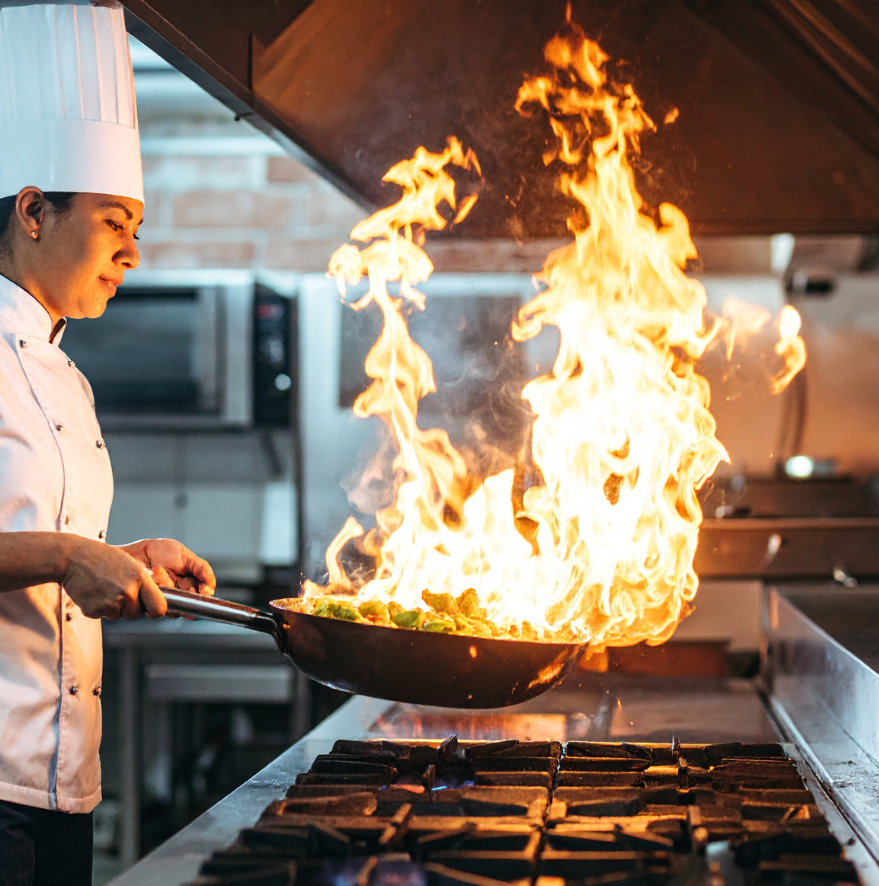There’s one fire every day in a commercial kitchen in the UK.
This statistic should make us all sit up and take notice.
A fire doesn’t just threaten business continuity— 80% of businesses never re-open following a serious fire—but it can also lead to huge fines, custodial sentences, and loss of life in the worst-case scenarios.
As we’ll reveal in this article, most commercial kitchen fires can be prevented by being diligent, planning ahead, and creating a fire-safe culture across the board.
With the help of a couple of our members, we get to the bottom of how to make a commercial kitchen as fire-safe as possible.
We spoke with David Hathway, Business Development Manager at Global Fire and Security Systems, and Nigel Roddie, Sales Director at Marlowe Kitchen Fire Suppression, to get their tips.
What are the most common fire safety risks in commercial kitchens, and how can operators identify, address, and manage them?

David Hathway:
Commercial kitchens face several common fire safety risks, primarily due to high temperatures, flammable materials, and the intensive use of the cooking equipment.
The main risks include:
- The grease build-up in ventilation systems.
- Faulty or poorly maintained cooking equipment.
- Improper storage or handling of flammable materials.
- Human error.
To mitigate these risks, operators must implement regular cleaning and maintenance schedules, train staff on safe cooking practices and fire prevention, and ensure that the proper storage and handling of flammable substances is in place.
For example, if you’ve got a tub of grease paper towels stored near hot cooking equipment, these should instead be stored away from the cooking area in well-ventilated rooms to eradicate that risk.
How have recent updates to UK fire safety regulations impacted the responsibilities of commercial kitchen operators?

Nigel Roddie:
There’s minimal impact, as far as I’m concerned.
Ultimately, to comply with the Regulatory Reform (Fire Safety) Order 2005 or the Fire (Scotland) Act 2005, the responsible person (or duty holder in Scotland) has to apply certain control measures to safeguard life on that property in any relevant premises.
They’ve got to take cognisance of any relevant persons, i.e., anybody else that would be impacted by a fire in their place. So, I don’t see that there’s any additional onerous work needed.
If you’re carrying out your duties under the Regulatory Reform (Fire Safety) Order 2005, you’re 99-100% of the way there with regard to the new legislation.
We often get asked, ‘Is kitchen fire suppression a legal requirement?’. It’s not, but the responsible person needs to evaluate the fire safety risks within the premises and put actions and training in place to mitigate that risk.
It may be that a portable fire extinguisher is perfectly acceptable for that risk. However, I find some customers still don’t fully understand how the legislation applies to them, and this is key.
What is the role of a responsible person in a commercial kitchen environment?
David:
The responsible person in a commercial kitchen can be anyone from a company owner to the kitchen manager. In some instances, the ‘responsible person’ may not actually be a person—it may be a corporate entity, such as a limited company.
Whoever the responsible person is, they need to ensure that all fire systems and equipment are up to date and compliant with fire safety standards as a minimum requirement.
They’re also responsible for ensuring that all kitchen staff are aware of—and have been fully trained on—the locations and functions of all fire-related items in the area.
For example, fire extinguisher placement in the kitchen, fire suppression operation, and fire alarm activations and procedures.
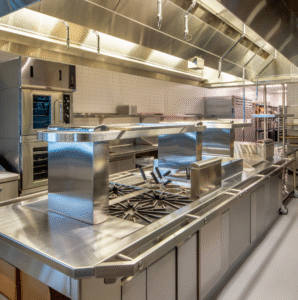
Can you explain the importance of regular fire risk assessments in commercial kitchens, and what should these assessments focus on?
Nigel:
Regular reviews of a commercial kitchen’s fire risk assessment will ensure that the assessment remains suitable and sufficient and that the appropriate fire safety control measures remain in place.
Key focus areas should include ensuring staff competency with the appliances, looking at the equipment that’s in use in the kitchen, and ensuring routine checks and maintenance are being completed.
The results must be recorded for evidence when any future assessments or audits are undertaken by the enforcing authority.
Sometimes, people get the paperwork, don’t take any notice of what’s in there, file it away, and pay the money. This has huge potential ramifications if a fire were to occur, as the report could contain safety-critical recommendations that haven’t been actioned. These recommendations should be given suitable priority and completed within an appropriate timescale.
One thing we’ve seen over the last couple of years is the resurgence of barbecue cooking inside. So, where once chargrills were gas, a lot of commercial kitchen operators are now reverting back to using either natural charcoals or wood.
If they make any such changes to their cooking equipment, it may be time to revisit their fire risk assessment. By doing this, they can potentially pursue an alternative method of fighting fires on their premises.
How often should a fire risk assessment be reviewed to ensure ongoing compliance?
David:
There isn’t a specific legal time frame, but generally, we would recommend an annual review.
However, more frequent reviews may be necessary if:
- There are significant changes to the building’s layout or usage.
- The building’s occupants raise new fire safety concerns.
- There’s any other reason to believe the existing assessment is no longer valid.
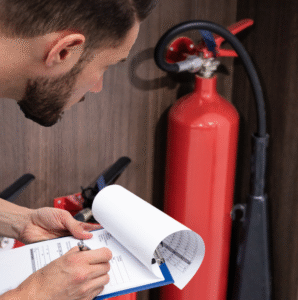
How do staff training and fire drills help to maintain fire safety, what should these training drills include, and how often should they be conducted?
Nigel:
Staff training and fire drills create a proactive culture in a commercial kitchen.
The training should be specific to the kitchen and cover potential fire hazards, the safe usage of firefighting appliances, and so on.
Not everyone within the kitchen environment has to be trained up on fire safety, but you should provide suitable training to the nominated people, i.e., more experienced members of staff.
If you’re working in a high-risk environment, your training should focus on fire extinguisher operation, the type of extinguisher you’re using, and the location of the isolation switches. Long-term, induction training and annual refresher training should be provided to ensure ongoing compliance.
A lot of people treat drills as a tick-box exercise, but they’re absolutely critical to keeping your environment as fire-safe as possible.
Ideally, drills should take place at least every six months and should take into account a fire originating in the kitchen. Your kitchen staff must participate in at least one drill per year so that they know how to respond in the event of a fire.
Normally, the kitchen staff will just react to the fire alarm going off somewhere else in the building, so it’s important to change up the scenarios. Make sure there’s a scenario of a fire in the kitchen.
And make sure staff know about the isolation switches and feel confident operating the nearest break-glass call point.
It’s vital that there’s a debrief after each drill and your evacuation plans are amended accordingly. If something didn’t quite go to plan, you can review and amend your drill procedure(s).
What are the best practices for maintaining kitchen extraction and ventilation systems to minimise fire safety risks?
David:
Regular cleaning, carried out by either the staff on-site or specialised contractors, will help to avoid grease build-up.
So, too, will continuous servicing of the extraction system. It’s essential that grease build-up doesn’t become too accessible there, as it can become a major fire risk.
A good extraction system also helps with the operation of fire suppression. When the fire suppression is released, it’ll turn into a kind of mist. The extraction fan will then draw that mist through the fire ventilation system and out into the atmosphere.
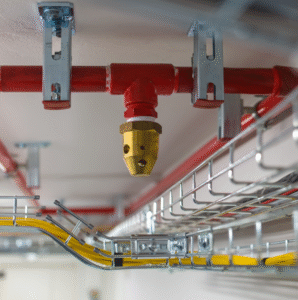
Which fire detection and suppression systems are most suitable for commercial kitchens?
Nigel:
Ultimately, you don’t want false or unwanted activations. If you get these types of activations from your fire detection or fire suppression system, people will just take this blasé attitude that it’s a false alarm which they don’t have to act on.
There are many types of fire detection systems you can purchase. There are even smoke detectors that are suitable in commercial kitchens and clever enough to distinguish between normal smoke and smoke containing fire chemicals and vapours.
In terms of kitchen suppression systems, there are various factors to consider when choosing the right type of system.
As with detection systems, you don’t want a suppression system that goes off falsely and causes constant disruption to your service.
When it does go off, you need time to clean down, and you could end up losing a valuable amount of foodservice time or even have to close down for the day. This obviously leads to lost income that could have been avoided if you’d purchased a different system.
You want a robust system that does what it’s required to do when called upon, either automatically or manually.
What are some common oversights you witness in commercial kitchens when it comes to fire safety, and how can they be avoided?
David:
As I mentioned, grease build-up is one of the biggest—if not the biggest—fire risks in a commercial kitchen, and this is caused by poor cleaning methods, or a lack of cleaning methods altogether.
This can be rectified by establishing regular cleaning methods and utilising professional companies.
It’s also essential that the baffle filters are in place when cooking, as this prevents further grease build-up.
Improper storage of flammable materials around heat sources is a common oversight—for example, cleaning chemicals and paper towels. These materials need to be stored well away from the risk area in a well-ventilated room.
Faulty cooking equipment is another common oversight. Deep fat fryers or grills can malfunction and cause fires if not properly maintained or kept clean.
The responsible person on-site must:
- Implement regular maintenance schedules for all kitchen equipment, including daily checks and professional servicing intervals.
- Address any suspected issues immediately by arranging repairs or replacements in consultation with a qualified professional.
What advice would you give to kitchen operators to help them stay compliant and ahead of regulatory changes?
Nigel:
Provide staff with continuous training at suitable intervals so that they’re fully conversant with the actions that need to be taken in the event of a fire.
You must also give a percentage of your staff practical training on the safe use and limitations of the firefighting equipment installed in your kitchen.
Identify any young persons (i.e., persons aged 18 years or under) working in the kitchen and complete a young person’s risk assessment (YPRA).
Finally, review your risk assessment as and when considered necessary.
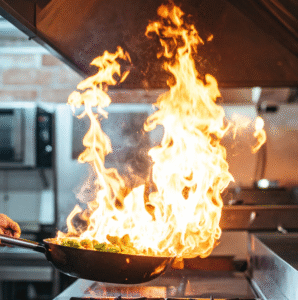
Can you share an example of a fire incident in a commercial kitchen and the lessons learnt from it?
David:
A couple of years ago, we had a kitchen fire suppression system activate, and when the engineer attended the site, he found it had been manually set off.
The staff member who set it off thought she was shutting off the gas.
This incident could have been avoided through proper equipment training, provided either by the engineer, myself, or the operations manager.
It’s so important for staff to know what’s what around the kitchen, especially when it comes to fire safety. So, this is a cautionary tale, for sure.
How can you assist commercial kitchen operators in making their kitchens as fire-safe as possible?
David:
We provide a wide range of services relating to fire prevention, installation, and maintenance.
Our sister company, Global HSE Group, can assist with fire risk assessments and strategy, fire doors, fire stopping, and building remediations.
Global Fire and Security itself specialises in the installation and maintenance of:
- Portable fire extinguishers
- Kitchen fire suppression systems
- Fire alarms
- Automatic detection systems
- Emergency lighting and signage
Engineers can also provide staff training whilst installing or maintaining your equipment.
It’s good to tie in all of those services when we’re on-site. When we’re maintaining systems, particularly kitchen suppression systems, the system’s generally not in use and the chefs aren’t cooking.
So, this is a good opportunity for us to run through everything and for the kitchen operators to ask us questions on anything that they’re unsure of.
Many thanks to David for his insights. If you’d like to reach out to David to discuss any of the points raised in this article, you can do so by emailing [email protected].
Nigel:
We only deal with kitchen fire suppression systems for both commercial and residential applications, therefore the skill set and knowledge within our business is purely focussed on these systems, without the distraction of other fire safety systems
We have a major advantage being part of the wider Marlowe PLC, which comprises fire detection companies, passive fire protection specialists, qualified, experienced fire risk assessors, ductwork cleaners, and water treatment specialists.
In essence, fire safety for commercial kitchens is what we do. We’re dedicated to this market .
When we look at a commercial kitchen, we look at its cooking equipment and range of risks and advise the best system for it—not only to keep the restaurant safe, but also to avoid any false alarms.
Our systems will extinguish the fire in three seconds. That’s it—gone.
This means you don’t have to evacuate people out the door in the event of a fire and lose X amount of money.
Many thanks to Nigel for his insights. If you’d like to reach out to Nigel to discuss any of the points raised in this article, you can do so by emailing [email protected].
